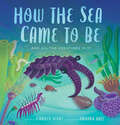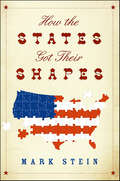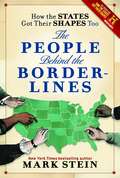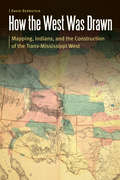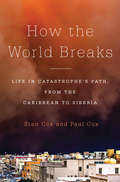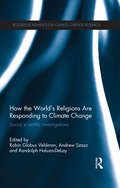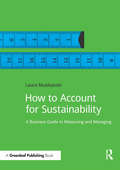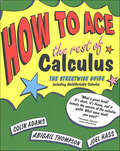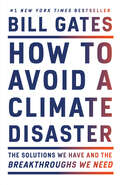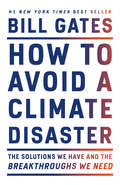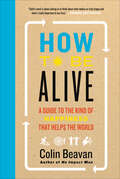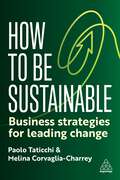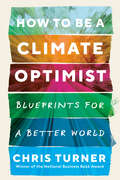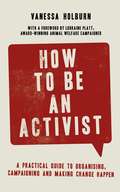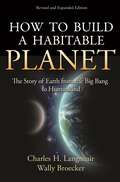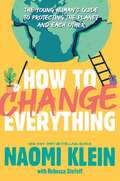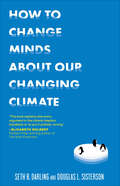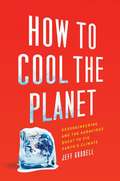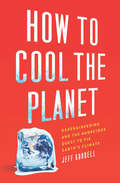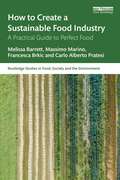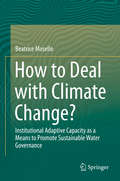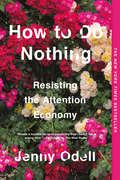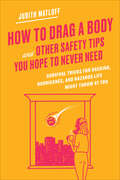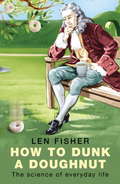- Table View
- List View
How the Sea Came to Be: (And All the Creatures In It)
by Jennifer BerneA lyrical, spectacular history of the ocean—from its dramatic evolutionary past to its marvelously biodiverse present.&“For millions of years these first bits of lifeBecame more, and then more, and then more.&”Long, long ago, when the Earth was young and new, the world was a fiery place. Volcanoes exploded from deep down below, and steamy, hot clouds rose up high. Rain poured down for thousands of years, filling the world&’s very first oceans. There the teeniest stirrings of life began. Earth&’s creatures grew bigger and bigger, evolving into exciting forms like jellyfish, coral, and worms. Millions of years passed. Down in the depths and up on the surface, ocean life grew and spread. Now the sea teems with all kinds of animals—squid, turtles, dolphins, barracudas, even glowing fish, all living in the waters where long, long ago, life itself came to be. Spanning 4.5 billion years of evolution, this extensively researched book is an accessible introduction to geology, oceanography, and marine biology. Entrancing verse, awe-inspiring art, and fascinating back matter capture the mysterious beauty of the ocean and the incredible organisms who call it home.
How the States Got Their Shapes
by Mark SteinNew York Times Bestseller"Give me the splendid irregularities any day. God bless the panhandles and notches, the West Virginias and Oklahomas." -- Wall Street JournalWhy does Oklahoma have that panhandle? Did someone make a mistake? We are so familiar with the map of the United States that our state borders seem as much a part of nature as mountains and rivers. Even the oddities—the entire state of Maryland(!)—have become so ingrained that our map might as well be a giant jigsaw puzzle designed by Divine Providence. How the States Got Their Shapes is the first book to tackle why our state lines are where they are. Here are the stories behind the stories, right down to the tiny northward jog at the eastern end of Tennessee and the teeny-tiny (and little known) parts of Delaware that are not attached to Delaware but to New Jersey. Packed with fun oddities and trivia, this entertaining guide also reveals the major fault lines of American history, from ideological intrigues and religious intolerance to major territorial acquisitions. Adding the fresh lens of local geographic disputes, military skirmishes, and land grabs, Mark Stein shows how the seemingly haphazard puzzle pieces of our nation fit together perfectly.
How the States Got Their Shapes Too: The People Behind the Borderlines
by Mark SteinWas Roger Williams too pure for the Puritans, and what does that have to do with Rhode Island? Why did Augustine Herman take ten years to complete the map that established Delaware? How did Rocky Mountain rogues help create the state of Colorado? All this and more is explained in Mark Stein's new book.How the States Got Their Shapes Too follows How the States Got Their Shapes looks at American history through the lens of its borders, but, while How The States Got Their Shapes told us why, this book tells us who. This personal element in the boundary stories reveals how we today are like those who came before us, and how we differ, and most significantly: how their collective stories reveal not only an historical arc but, as importantly, the often overlooked human dimension in that arc that leads to the nation we are today.The people featured in How the States Got Their Shapes Too lived from the colonial era right up to the present. They include African Americans, Native Americans, Hispanics, women, and of course, white men. Some are famous, such as Thomas Jefferson, John Quincy Adams, and Daniel Webster. Some are not, such as Bernard Berry, Clarina Nichols, and Robert Steele. And some are names many of us know but don't really know exactly what they did, such as Ethan Allen (who never made furniture, though he burned a good deal of it).In addition, How the States Got Their Shapes Too tells of individuals involved in the Almost States of America, places we sought to include but ultimately did not: Canada, the rest of Mexico (we did get half), Cuba, and, still an issue, Puerto Rico. Each chapter is largely driven by voices from the time, in the form of excerpts from congressional debates, newspapers, magazines, personal letters, and diaries. Told in Mark Stein's humorous voice, How the States Got Their Shapes Too is a historical journey unlike any other you've taken. The strangers you meet here had more on their minds than simple state lines, and this book makes for a great new way of seeing and understanding the United States.From the Hardcover edition.
How the West Was Drawn: Mapping, Indians, and the Construction of the Trans-Mississippi West (Borderlands and Transcultural Studies)
by David BernsteinHow the West Was Drawn explores the geographic and historical experiences of the Pawnees, the Iowas, and the Lakotas during the European and American contest for imperial control of the Great Plains during the eighteenth and nineteenth centuries. David Bernstein argues that the American West was a collaborative construction between Native peoples and Euro-American empires that developed cartographic processes and culturally specific maps, which in turn reflected encounter and conflict between settler states and indigenous peoples. Bernstein explores the cartographic creation of the Trans-Mississippi West through an interdisciplinary methodology in geography and history. He shows how the Pawnees and the Iowas—wedged between powerful Osages, Sioux, the horse- and captive-rich Comanche Empire, French fur traders, Spanish merchants, and American Indian agents and explorers—devised strategies of survivance and diplomacy to retain autonomy during this era. The Pawnees and the Iowas developed a strategy of cartographic resistance to predations by both Euro-American imperial powers and strong indigenous empires, navigating the volatile and rapidly changing world of the Great Plains by brokering their spatial and territorial knowledge either to stronger indigenous nations or to much weaker and conquerable American and European powers.How the West Was Drawn is a revisionist and interdisciplinary understanding of the global imperial contest for North America’s Great Plains that illuminates in fine detail the strategies of survival of the Pawnees, the Iowas, and the Lakotas amid accommodation to predatory Euro-American and Native empires.
How the World Breaks: Life in Catastrophe's Path, from the Caribbean to Siberia
by Stan Cox Paul CoxWe've always lived on a dangerous planet, but its disasters aren't what they used to be. How the World Breaks gives us a breathtaking new view of crisis and recovery on the unstable landscapes of the Earth's hazard zones. Father and son authors Stan and Paul Cox take us to the explosive fire fronts of overheated Australia, the future lost city of Miami, the fights over whether and how to fortify New York City in the wake of Sandy, the Indonesian mud volcano triggered by natural gas drilling, and other communities that are reimagining their lives after quakes, superstorms, tornadoes, and landslides.In the very decade when we should be rushing to heal the atmosphere and address the enormous inequalities of risk, a strange idea has taken hold of global disaster policy: resilience. Its proponents say that threatened communities must simply learn the art of resilience, adapt to risk, and thereby survive. This doctrine obscures the human hand in creating disasters and requires the planet's most beleaguered people to absorb the rush of floodwaters and the crush of landslides, freeing the world economy to go on undisturbed. The Coxes' great contribution is to pull the disaster debate out of the realm of theory and into the muck and ash of the world's broken places. There we learn that change is more than mere adaptation and life is more than mere survival. Ultimately, How the World Breaks reveals why--unless we address the social, ecological, and economic roots of disaster--millions more people every year will find themselves spiraling into misery. It is essential reading for our time.
How the World's Religions are Responding to Climate Change: Social Scientific Investigations (Routledge Advances in Climate Change Research)
by Andrew Szasz Robin Globus Veldman Randolph Haluza-DeLayA growing chorus of voices has suggested that the world’s religions may become critical actors as the climate crisis unfolds, particularly in light of international paralysis on the issue. In recent years, many faiths have begun to address climate change and its consequences for human societies, especially the world’s poor. This is the first volume to use social science to examine how religions are helping to address one of the most significant and far-reaching challenges of our time. While there is a growing literature in theology and ethics about climate change and religion, little research has been previously published about the ways in which religious institutions, groups and individuals are responding to the problem of climate change. Seventeen research-driven chapters are written by sociologists, anthropologists, geographers and other social scientists. This book explores what effects religions are having, what barriers they are running into or creating, and what this means for the global struggle to address climate change.
How to Account for Sustainability: A Simple Guide to Measuring and Managing (Doshorts Ser.)
by Laura MusikanskiLearn how to measure, manage and account for sustainability in your business in clear, simple and feasible steps.This book takes you from concept to innovation and back to action items for all aspects of sustainability. Each chapter has four sections: (1) a specific description of sustainability challenges, (2) an example of a business making a profit by sustainability problem, (3) an exercise challenging the reader to identify business solutions and (4) clear, simple takeaways.The book is structured around the world’s most accepted guidelines for sustainability reporting, the Global Reporting Initiative.
How to Ace the Rest of Calculus: The Streetwise Guide (How to Ace)
by Joel Hass Colin Adams Abigail ThompsonThe sequel to How to Ace Calculus, How to Ace the Rest of Calculus provides humorous and highly readable explanations of the key topics of second and third semester calculus-such as sequences and series, polor coordinates, and multivariable calculus-without the technical details and fine print that would be found in a formal text.
How to Avoid a Climate Disaster: The Solutions We Have and the Breakthroughs We Need
by Bill GatesIn this urgent, singularly authoritative book, Bill Gates sets out a wide-ranging, practical--and accessible--plan for how the world can get to zero greenhouse gas emissions in time to avoid an irreversibleclimate catastrophe.Bill Gates has spent a decade investigating the causes and effects of climate change. With the help and guidance of experts in the fields of physics, chemistry, biology, engineering, political science and finance, he has focused on exactly what must be done in order to stop the planet's slide toward certain environmental disaster. In this book, he not only gathers together all the information we need to fully grasp how important it is that we work towardnet-zero emissions of greenhouse gases but also details exactly what we need to do to achieve this profoundly important goal. He gives us a clear-eyed description of the challenges we face. He describes the areas in which technology is already helping to reduce emissions; where and how the current technology can be made to function more effectively; where breakthrough technologies are needed, and who is working on these essential innovations. Finally, he lays out a concrete plan for achieving the goal of zero emissions--suggesting not only policies that governments should adopt, but what we as individuals can do to keep our government, our employers and ourselves accountable in this crucial enterprise.As Bill Gates makes clear, achieving zero emissions will not be simple or easy to do, but by following the guidelines he sets out here, it is a goal firmly within our reach.
How to Avoid a Climate Disaster: The Solutions We Have and the Breakthroughs We Need
by Bill GatesIn this urgent, authoritative book, Bill Gates sets out a wide-ranging, practical--and accessible--plan for how the world can get to zero greenhouse gas emissions in time to avoid a climate catastrophe. <P><P>Bill Gates has spent a decade investigating the causes and effects of climate change. With the help of experts in the fields of physics, chemistry, biology, engineering, political science, and finance, he has focused on what must be done in order to stop the planet's slide to certain environmental disaster. In this book, he not only explains why we need to work toward net-zero emissions of greenhouse gases, but also details what we need to do to achieve this profoundly important goal. <P><P>He gives us a clear-eyed description of the challenges we face. Drawing on his understanding of innovation and what it takes to get new ideas into the market, he describes the areas in which technology is already helping to reduce emissions, where and how the current technology can be made to function more effectively, where breakthrough technologies are needed, and who is working on these essential innovations. Finally, he lays out a concrete, practical plan for achieving the goal of zero emissions--suggesting not only policies that governments should adopt, but what we as individuals can do to keep our government, our employers, and ourselves accountable in this crucial enterprise. <P><P>As Bill Gates makes clear, achieving zero emissions will not be simple or easy to do, but if we follow the plan he sets out here, it is a goal firmly within our reach. <P><P><b>A New York Times Bestseller</b>
How to Be Alive: A Guide to the Kind of Happiness That Helps the World
by Colin Beavan“This is the book where self-help turns into helping the world—and then turns back into helping yourself find a better life. Fascinating and timely!”—Bill McKibben, author of Eaarth: Making a Life on a Tough New PlanetWhat does it take to achieve a successful and satisfying life? Not long ago, the answer seemed as simple as following a straightforward path: college, career, house, marriage, kids, and a secure retirement. Not anymore. Staggering student loan debt, sweeping job shortages, a chronically ailing economy—plus the larger issues of global unrest, poverty, and our imperiled environment—make the search for fulfillment more challenging. And, as Colin Beavan, activist and author of No Impact Man, proclaims, more exciting.In this breakthrough book, Beavan extends a hand to those seeking more meaning and joy in life even as they engage in addressing our various world crises. How to Be Alive nudges the unfulfilled toward creating their own version of the Good Life—a life where feeling good and doing good intersect. He urges readers to reexamine the “standard life approaches” to pretty much everything and to experiment with life choices that are truer to their values, passions, and concerns.How do you stop placing limits on your potential impact? How do you make your choices really matter in everything from your clothing purchases to your career? How do you find the people who will most support you in your quest for a good life? To answer these questions and more, Beavan draws on classic literature and philosophy; surprising new scientific findings; and the uplifting personal stories of real-life “lifequesters”—people who are breaking away from those old broken paths, blazing fresh trails, and reveling in every step along the way.“There is a movement afoot for a better life and Colin Beavan is its prophet, with a new book as powerful as his already classic No Impact Man.”—John de Graaf, coauthor of Affluenza
How to Be Sustainable: Business Strategies for Leading Change
by Paolo Taticchi Melina Corvaglia-CharreyAmid the many challenges facing the world today - not least the climate crisis - the need for bold and steadfast leadership has never been greater. How to Be Sustainable uncovers the strategies that lead organizations to sustainable success. While over 90% of business leaders recognize the importance of sustainability, only 60% have a strategy in place. And many of these strategies are inefficient, ineffective, or simply don't go far enough to address the global challenges we are facing.Leading sustainability expert Paolo Taticchi and co-author Melina Corvaglia-Charrey have interviewed some of the world's leading Chief Sustainability Officers from various sectors and businesses including Enel Group, Microsoft, Canon, and Sage. Guided by expert insights and real-world examples of sustainable practices, this book explores the impact and significance of sustainability in business, offering practical strategies and tools that will allow you and your business to make a positive impact. Whether you're an experienced leader, an aspiring CSO, or passionate about sustainability, the insights shared in this book will empower and inspire you to shape a better world for future generations.
How to Be a Climate Optimist: Blueprints for a Better World
by Chris TurnerFrom the National Business Book Award winner and GG finalist, a very different book about facing the climate crisis, and what awaits us on the other side.Chris Turner has reported from the places where the sustainable future first emerged—from green islands in Denmark and green office parks in southern India, to solar panel factories in California and idealistic intentional communities from Scotland to New Mexico. Here, he condenses the first quarter century of the global energy transition into bite-sized chunks of optimistic reflection and reportage, telling a story of a planet in peril and a global effort already beginning to save it. This is a book that moves past the despair and futile anger over ecological collapse and harnesses that passion toward the project of building a twenty-first century quality of life that surpasses the twentieth-century version in every way. How to Be a Climate Optimist overflows with possibility in a moment of great panic, upheaval and uncertainty over a world on fire.
How to Be an Activist: A practical guide to organising, campaigning and making change happen
by Vanessa HolburnFrom experienced campaigner Vanessa Holburn and with a foreword by award-winning animal welfare campaigner Lorraine Platt, this is the essential guide to activism. 'Essential reading for anyone looking to start a grassroots campaign - and useful bedtime reading for some of our political parties too' - Hannah Beckerman, GuardianHow To Be an Activist covers everything you need to know to create a successful social campaign and bring about positive change no matter what your cause. This practical, inspirational book covers topics ranging from identifying your central issue and setting meaningful milestones and goals, to learning how to use the media effectively and stay safe and within the law. It will help you with every step of your campaign, keeping you motivated through periods of self-doubt and staving off burnout as you celebrate milestones on the way to creating meaningful change in the world. With contributions from influential campaigners including Natasha Devon MBE.Fresh from waving banners in the pouring rain, journalist and campaigner Vanessa Holburn passes on the lessons she has learned so the reader can fast track their movement to success. This is the age of activism and everyone is invited to join the movement.
How to Be an Activist: A practical guide to organising, campaigning and making change happen
by Vanessa HolburnFrom experienced campaigner Vanessa Holburn and with a foreword by award-winning animal welfare campaigner Lorraine Platt, this is the essential guide to activism. 'Essential reading for anyone looking to start a grassroots campaign - and useful bedtime reading for some of our political parties too' - Hannah Beckerman, GuardianHow To Be an Activist covers everything you need to know to create a successful social campaign and bring about positive change no matter what your cause. This practical, inspirational book covers topics ranging from identifying your central issue and setting meaningful milestones and goals, to learning how to use the media effectively and stay safe and within the law. It will help you with every step of your campaign, keeping you motivated through periods of self-doubt and staving off burnout as you celebrate milestones on the way to creating meaningful change in the world. With contributions from influential campaigners including Natasha Devon MBE.Fresh from waving banners in the pouring rain, journalist and campaigner Vanessa Holburn passes on the lessons she has learned so the reader can fast track their movement to success. This is the age of activism and everyone is invited to join the movement.
How to Build a Habitable Planet: The Story of Earth from the Big Bang to Humankind - Revised and Expanded Edition
by Charles H. Langmuir Wallace BroeckerA classic introduction to the story of Earth's origin and evolution—revised and expanded for the twenty-first centurySince its first publication more than twenty-five years ago, How to Build a Habitable Planet has established a legendary reputation as an accessible yet scientifically impeccable introduction to the origin and evolution of Earth, from the Big Bang through the rise of human civilization. This classic account of how our habitable planet was assembled from the stuff of stars introduced readers to planetary, Earth, and climate science by way of a fascinating narrative. Now this great book has been made even better. Harvard geochemist Charles Langmuir has worked closely with the original author, Wally Broecker, one of the world's leading Earth scientists, to revise and expand the book for a new generation of readers for whom active planetary stewardship is becoming imperative.Interweaving physics, astronomy, chemistry, geology, and biology, this sweeping account tells Earth’s complete story, from the synthesis of chemical elements in stars, to the formation of the Solar System, to the evolution of a habitable climate on Earth, to the origin of life and humankind. The book also addresses the search for other habitable worlds in the Milky Way and contemplates whether Earth will remain habitable as our influence on global climate grows. It concludes by considering the ways in which humankind can sustain Earth’s habitability and perhaps even participate in further planetary evolution.Like no other book, How to Build a Habitable Planet provides an understanding of Earth in its broadest context, as well as a greater appreciation of its possibly rare ability to sustain life over geologic time.Leading schools that have ordered, recommended for reading, or adopted this book for course use:Arizona State UniversityBrooklyn College CUNYColumbia UniversityCornell UniversityETH ZurichGeorgia Institute of TechnologyHarvard UniversityJohns Hopkins UniversityLuther CollegeNorthwestern UniversityOhio State UniversityOxford Brookes UniversityPan American UniversityRutgers UniversityState University of New York at BinghamtonTexas A&M UniversityTrinity College DublinUniversity of BristolUniversity of California-Los AngelesUniversity of CambridgeUniversity Of ChicagoUniversity of Colorado at BoulderUniversity of GlasgowUniversity of LeicesterUniversity of Maine, FarmingtonUniversity of MichiganUniversity of North Carolina at Chapel HillUniversity of North GeorgiaUniversity of NottinghamUniversity of OregonUniversity of OxfordUniversity of PortsmouthUniversity of SouthamptonUniversity of UlsterUniversity of VictoriaUniversity of WyomingWestern Kentucky UniversityYale University
How to Change Everything: The Young Human's Guide to Protecting the Planet and Each Other
by Naomi KleinAn empowering, engaging young readers guide to understanding and battling climate change from the expert and bestselling author of This Changes Everything and On Fire, Naomi Klein.Warmer temperatures. Fires in the Amazon. Superstorms. These are just some of the effects of climate change that we are already experiencing. The good news is that we can all do something about it. A movement is already underway to combat not only the environmental effects of climate change but also to fight for climate justice and make a fair and livable future possible for everyone. And young people are not just part of that movement, they are leading the way. They are showing us that this moment of danger is also a moment of great opportunity—an opportunity to change everything. Full of empowering stories of young leaders all over the world, this information-packed book from award-winning journalist and one of the foremost voices for climate justice, Naomi Klein, offers young readers a comprehensive look at the state of the climate today and how we got here, while also providing the tools they need to join this fight to protect and reshape the planet they will inherit.
How to Change Minds About Our Changing Climate
by Seth B. Darling Douglas L. SistersonThe book to spark action on the defining challenge of our time In our post-truth world, there’s only one place to turn to if we want to live in reality: science. And the research on climate change is clear: It’s real, it threatens us all, and human activity is the primary cause. This essential handbook dismantles all the most pernicious misunderstandings spread by deniers and replaces them with the truth. Faced with an imperiled planet that we must urgently work to save, we don’t have time for anything else.
How to Cool the Planet: Geoengineering and the Audacious Quest to Fix Earth's Climate
by Jeff GoodellWhen Jeff Goodell first encountered the term "geoengineering," he had a vague sense that it involved outlandish schemes to counteract global warming. As a journalist, he was deeply skeptical. But he was also intrigued. The planet was in trouble. Could geoengineers help? Climate change may well be the biggest crisis humanity has ever faced. Temperatures in some regions of the world could increase by as much as fifteen degrees by the end of the century, causing rising sea levels and severe droughts. But change could also happen much more suddenly. What if we had a real climate emergency, the ecological equivalent of the subprime mortgage meltdown -- how could we cool the planet in a hurry? As Goodell shows in this bracing book, even if we could muster the political will for it, cutting greenhouse gas emissions alone may not be enough to reduce the risk of climate catastrophe. This has led some scientists to pursue extreme solutions: huge contraptions that would suck CO2 from the air, machines that would brighten clouds and deflect sunlight away from the earth, even artificial volcanoes that would spray heat-reflecting particles into the atmosphere. In How to Cool the Planet, Goodell explores the scientific, political, financial, and moral aspects of geoengineering. How are we to change the temperature of whole regions if we can't even predict next week's weather? What if a wealthy entrepreneur shoots particles into the stratosphere on his own? What about wars waged with climate control as the primary weapon? What happens to our relationship with nature when, as Goodell puts it, we all find ourselves living in a giant terrarium? And our options are dwindling. Maybe, Goodell suggests, we need to start taking geoengineering seriously. Maybe it's Plan B for the planet. And if it is, we need to know enough to get it right. Thoroughly reported and convincingly argued, How to Cool the Planet is a compelling tale of scientific hubris and technical daring. But it is also a thoughtful, even-handed look at a deeply complex and controversial issue. It's a book that will surely jump-start the next big debate about the future of life on earth.
How to Cool the Planet: Geoengineering and the Audacious Quest to Fix Earth's Climate
by Jeff Goodell&“Thoughtful, informative, and darkly entertaining. It&’s the best treatment of this important (and scary) topic you can find.&” —Elizabeth Kolbert Right now, a group of scientists is working on ways to minimize the catastrophic impact of global warming. But they&’re not designing hybrids or fuel cells or wind turbines. They&’re trying to lower the temperature of the entire planet. And they&’re doing it with huge contraptions that suck CO2 from the air, machines that brighten clouds and deflect sunlight away from the earth, even artificial volcanoes that spray heat-reflecting particles into the atmosphere. This is the radical and controversial world of geoengineering, which only five years ago was considered to be &“fringe.&” But as Jeff Goodell points out, the economic crisis, combined with global political realities, is making these ideas look sane, even inspired. Goodell himself started out as a skeptic, concerned about tinkering with the planet&’s thermostat. We can&’t even predict next week&’s weather, so how are we going to change the temperature of whole regions? What if a wealthy entrepreneur shoots particles into the stratosphere on his own? Who gets blamed if something goes terribly wrong? And perhaps most disturbing, what about wars waged with climate control as the primary weapon? There are certainly risks, but Goodell believes the alternatives could be worse. In the end, he persuades us that geoengineering may just be our last best hope—a Plan B for the environment. His compelling tale of scientific hubris and technical daring is sure to jump-start the next big debate about the future of life on earth. &“Goodell explores with infectious curiosity and thoughtful narration this strange, promising, and untested suite of climate fixes.&” —BusinessWeek &“A quick, enjoyable read through a complex, timely topic. And after you read it, you&’ll never look at the sky or the ocean—or Earth, really—in quite the same way again.&” —The Christian Science Monitor
How to Create a Sustainable Food Industry: A Practical Guide to Perfect Food (Routledge Studies in Food, Society and the Environment)
by Massimo Marino Melissa Barrett Francesca Brkic Carlo Alberto PratesiThis book presents a practical guide to help businesses navigate the complex topics of sustainability in the food industry. The book takes you on a journey along the food value chain, from farm to fork, exploring key opportunities to increase positive impacts and circularity at each step of the journey. Written by a team of authors with decades of experience in the food industry and academia, it provides guidance on how to analyse sustainability across the value chain and life cycle of a food product and how to design, implement and communicate strategies to customers. Furthermore, the book shows that there are not always straightforward solutions, but rather choices and trade-offs that require an understanding of what is best suited to the product, customers and business in question. It demystifies a variety of topics, such as local sourcing, regenerative agriculture, plant-based protein and the environmental impact of meat production, and draws on a wide range of case studies from across the globe, to provide concrete, real-world examples. While a perfect food system may not exist, informed decisions can go a long way to reshape and transform the food industry as we know it. This book will be of great interest to professionals working in the food and agriculture industries, as well as students and scholars of sustainable food systems and sustainable business.
How to Deal with Climate Change?
by Beatrice MoselloAs the evidence for human-induced climate change becomes more obvious, so too does the realisation that it will harshly impact on the natural environment as well as on socio-economic systems. Addressing the unpredictability of multiple sources of global change makes the capacity of governance systems to deal with uncertainty and surprise essential. However, how all these complex processes act in concert and under which conditions they lead to the sustainable governance of environmental resources are questions that have remained relatively unanswered. This book aims at addressing this fundamental gap, using as case examples the basins of the Po River in Northern Italy and the Syr Darya River in Kyrgyzstan. The opening chapter addresses the challenges of governing water in times of climate and other changes. Chapter Two reviews water governance through history and science. The third chapter outlines a conceptual framework for studying institutional adaptive capacity. The next two chapters offer detailed case studies of the Po and Syr Darya rivers, followed by a chapter-length analysis and comparison of adaptive water resources management in the two regions. The discussion includes a description of resistant, reactive and proactive institutions and puts forward ideas on how water governance regimes can transition from resistant to proactive. The final chapter takes a high-level view of lessons learned and how to transform these into policy recommendations and offers a perspective on embracing uncertainty and meeting future challenges.
How to Do Nothing: Resisting the Attention Economy
by Jenny OdellA galvanizing critique of the forces vying for our attention—and our personal information—that redefines what we think of as productivity, reconnects us with the environment, and reveals all that we’ve been too distracted to see about ourselves and our world <P><P>Nothing is harder to do these days than nothing. But in a world where our value is determined by our 24/7 data productivity . . . doing nothing may be our most important form of resistance. So argues artist and critic Jenny Odell in this field guide to doing nothing (at least as capitalism defines it). <P><P>Odell sees our attention as the most precious—and overdrawn—resource we have. Once we can start paying a new kind of attention, she writes, we can undertake bolder forms of political action, reimagine humankind’s role in the environment, and arrive at more meaningful understandings of happiness and progress. <P><P>Far from the simple anti-technology screed, or the back-to-nature meditation we read so often, How to do Nothing is an action plan for thinking outside of capitalist narratives of efficiency and techno-determinism. Provocative, timely, and utterly persuasive, this book is a four-course meal in the age of Soylent. <P><P><b>A New York Times Bestseller</b>
How to Drag a Body and Other Safety Tips You Hope to Never Need: Survival Tricks for Hacking, Hurricanes, and Hazards Life Might Throw at You
by Judith Matloff“Matloff assesses major threats with careful authority and good humor, then gives us the logistical and emotional tools necessary to cope with them.” —Ada Calhoun, New York Times–bestselling author of Why We Can’t SleepIn an age of anxiety, we yearn for some control. We want to make sensible decisions to keep us on track when everything seems to be going off the rails. As a seasoned war correspondent with over thirty years of experience in crisis zones and a pioneering safety consultant, Judith Matloff knows about personal security and risk management. In How to Drag a Body and Other Safety Tips You Hope to Never Need, she shares her tried-and-true methods to help you confidently handle whatever challenges comes your way. Learn how to:Perform emergency first aidCreate a bunkerKeep yourself safe when travelingKeep yourself safe onlineKeep yourself safe in any circumstance with invaluable tips on dozens of other situationsBlending humorous anecdotes with serious advice, Matloff explains how to remain upright in stampedes, avoid bank fraud, prevent sexual assault, stay clean in a shelter, and even be emotionally prepared for loss. From cybersecurity and active shooter situations to natural disasters and emotional resilience, her tips will give even the most anxious person a sense of control over life’s unpredictable perils. Unfortunately, we can’t anticipate all the crises of our lives. But with this book, you’ll find the skills and confidence you need to weather an emergency.Includes illustrations“This wise and witty book will tell you everything you need to know in order to face catastrophes great and small.” —Susan Cain, New York Times–bestselling author of Quiet
How to Dunk a Doughnut: Using Science in Everyday Life
by Dr Len FisherLen Fisher is a finalist for the prestigious Global Challenges New Shape prize.Fun, quirky popular science from the winner of an IgNobel Prize for achievements that cannot or should not be reproduced.Science is all around us. In this brilliant, entertaining book, Len Fisher provides scientific answers to familiar questions such as how to boil the perfect egg, how to catch a ball, the physics of sex, and why some vegetables absorb more gravy than others.In doing so, he reveals the world of the scientist - how they think, what they do, and how they go about doing it - proving that even the most commonplace activities can be used as a key to understanding the laws of nature and that experimental science can be fun!
